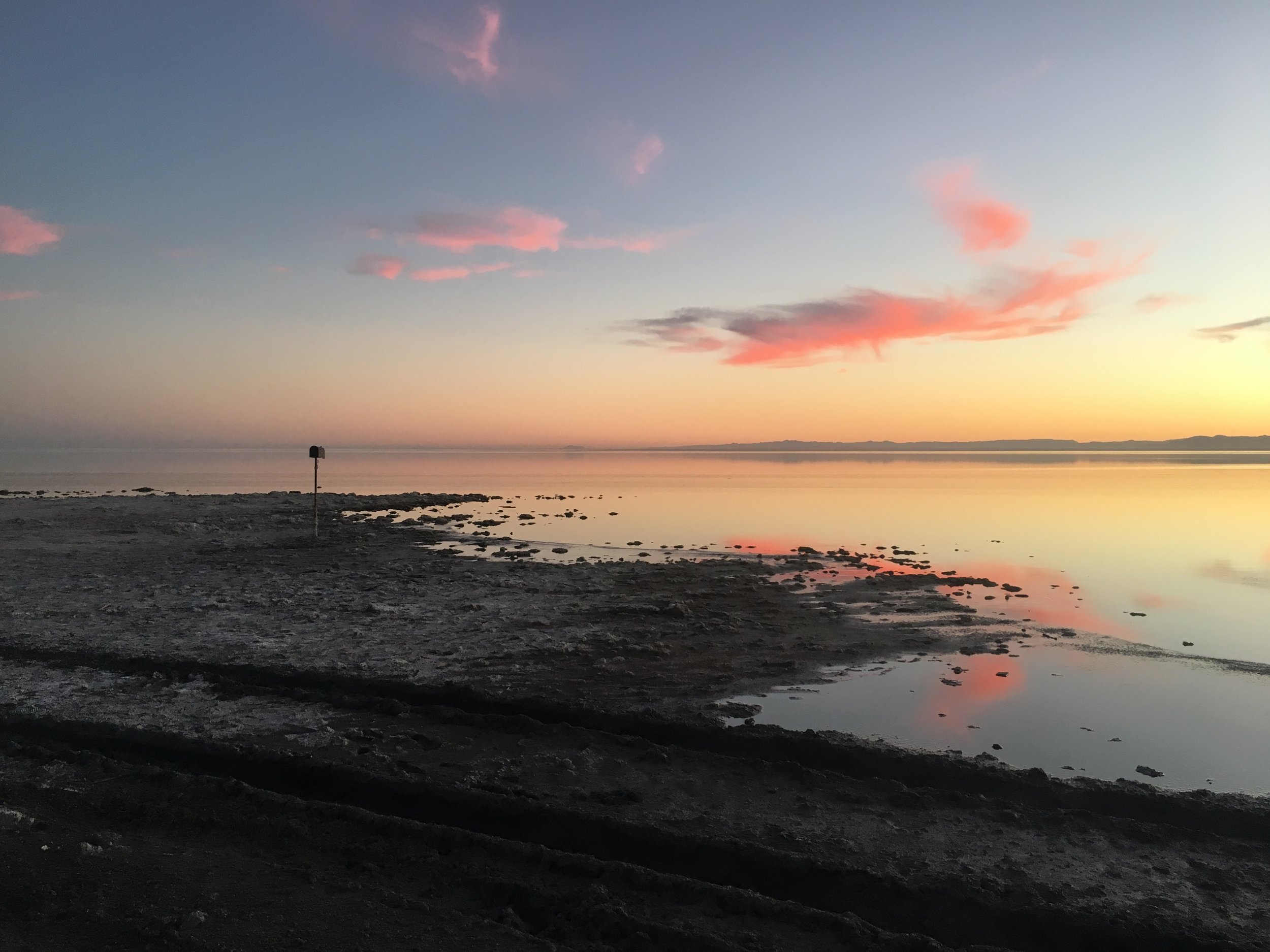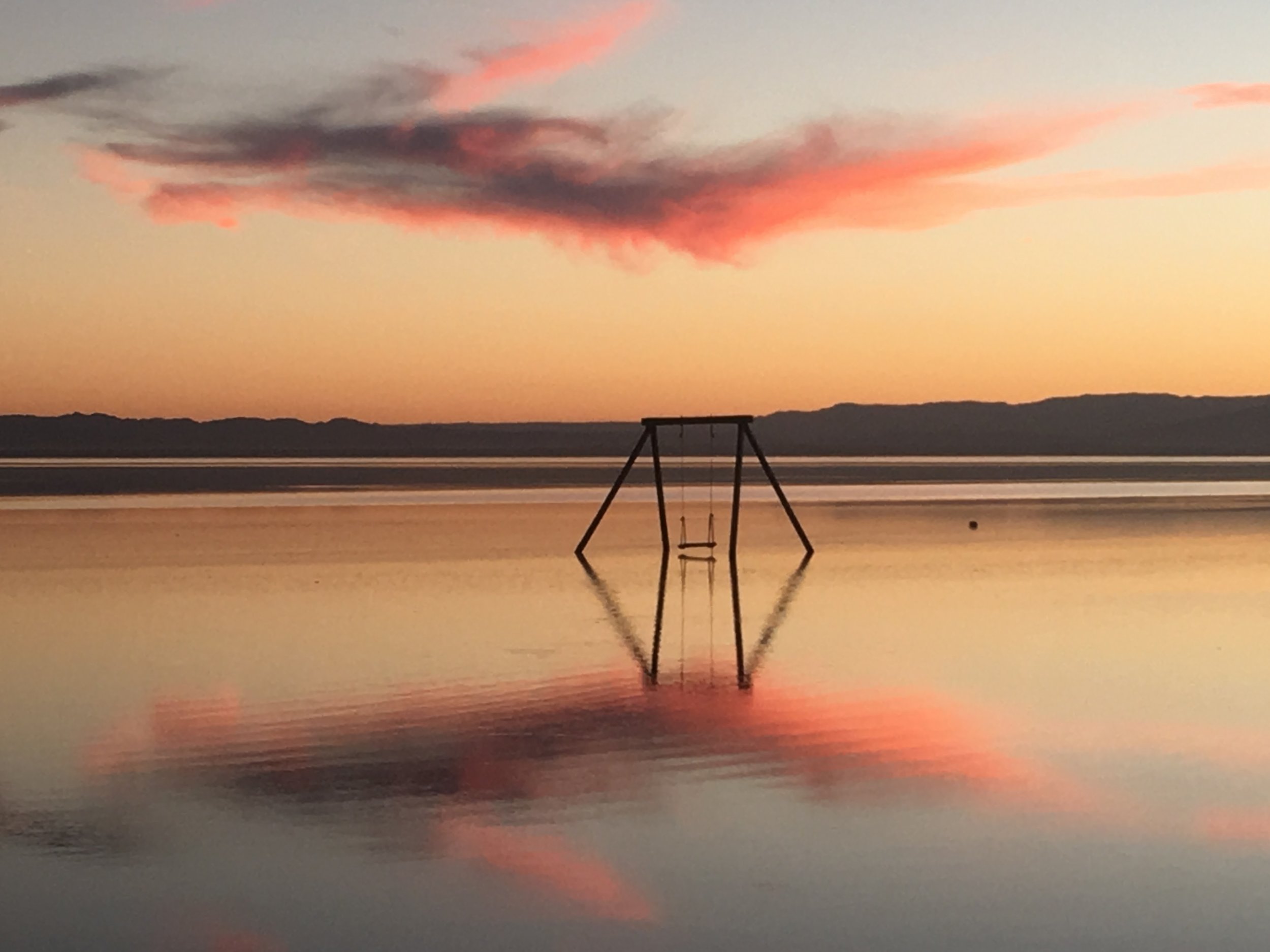ASCI Profile: Reed McConnell
I had a chance to talk to Reed McConnell—a third-year PhD student in the Anthropology Department and a current ASCI Graduate Fellow—about a recent trip she took to her field site, colonizing Mars, environmental disasters, ghost towns, and about the focus of her anthropological research.
–Naomi Blumberg
Assistant Director, ASCI
Salvation Mountain, a folk art monument in Slab City, CA, a half hour's drive south of Bombay Beach. Photo: Reed McConnell
What is your area of focus for your PhD?
My background is sort of in environmental studies, but that makes it sound like I’m an environmental scientist–I’m not. I did my master’s in the environmental humanities and before that, I studied anthropology as an undergraduate, along with German.
Post-college, I went on a road trip to visit ghost towns around the Southwest of the United States with a filmmaker friend. We were making a movie—half-documentary and half-fiction—about the end of the world, and about a company trying to prepare colonists to go to Mars. The idea was that our characters were sent out as representatives of the company to recruit colonists in the desert, assuming that they would be best-suited to moving to Mars. Over the course of the road trip, we went to all these rural areas and conducted lots of real-life interviews with people we met along the way. It was really incredible and transformative, for both of us. We had both grown up in Boston and we hadn’t spent any time in rural areas and, in particular, in the Southwest, which is so radically different from where we were from.
What happened to the movie you were making?
The movie is still unfinished. It was tabled for a few years. However, my co-filmmaker recently sent me all the footage, and we're both working on using it for different rough cuts. The two of us are also actually (as of a few months ago!) in the process of writing a speculative play together that is sort of riffing on the unmade movie and set in a near-future where the upper classes live entirely in skyscrapers. We hope to stage the play sometime soon.
So, how did your road trip shape the direction of your studies?
It’s fair to say that that trip changed my path quite a lot. I became obsessed with environmental pollution, dumping, and radioactivity, issues that are so prevalent in the Southwest. You can’t escape them when you’re there. So, for my master’s degree at Humboldt-Universität (Berlin), I focused on the questions that arose from that road trip. I studied the environmental humanities [an interdisciplinary field that explores not just the state of our changing natural surroundings but also the social/human relationship to the environment]. Though after my recent trip to my field site, I think I will be looking a lot more at economic anthropology than I originally thought, especially questions of investment.
How did you wind up in Berlin?
I had been studying German since middle school and continued through college and then studied abroad in Berlin during my junior year in college. I always hoped to go back. Actually, after the road trip, I moved there with a friend for two months and we just wrote (I’m also a writer!)* until our visas ran out. At that point, my German was at a level where I could study in it. So, I applied for a grant and was fully funded by the German government to do a two-year master’s degree. At first, I was just excited to go back and enjoy being there, but I wound up loving what I was studying.
What made you decide to come to the University of Chicago?
Chicago has one of the best anthropology PhD programs in the country, if not the world, so it's hard to say no to. I was particularly drawn to the opportunity to work with Joseph Masco and soon realized that there was an embarrassment of riches when it came to faculty in my department who were also invested in the issues that motivate my work. So, I feel very lucky.
Can you talk a little bit about your field site?
My field site is one of the places I visited on that first road trip. It’s a tiny town called Bombay Beach that’s located on the shores of the Salton Sea in southeastern California; it has about 240 residents and is about 40 miles from the closest supermarket. It has a single tiny convenience store. It’s in Imperial County, which is the driest desert area in the entire country, but they irrigate it like crazy. It’s so well irrigated that it’s one of the leading producers of winter vegetables in the U.S. It’s 110 degrees pretty consistently in the summer.
Bombay Beach is a strange place. Very isolated. Very different from the rest of California. There was a huge real estate boom in the 1950s and 60s around the Salton Sea because it was a popular vacation destination, but after significant flooding in the 1970s, most of the vacation homes in Bombay were abandoned. There are still some people there, but they are mostly relatively poor with very few resources or access to transportation. It’s primarily an older, retiree population, mostly people who went there early on and just stayed.
The Salton Sea at sunset. Photos: Reed McConnell
The strange thing about the town today, and something that will be central to my dissertation, is that in 2011, a Los Angeles-based filmmaker became really captivated by Bombay Beach and bought some real estate. And then, in 2016, he and two others started a yearly arts festival there. All of these artists started to come once a year, and they started to get invested in the place, and they started buying property. So, over the past five years, all of these artists have been moving in, and now there are a lot of incredible sculptures there, public art that did not exist at all when I first went there. In the last few years, the artists’ community has become a powerful and really visible part of the town.
Have other sites from your travels informed how you will approach your study of Bombay Beach?
Well, my project is nontraditional in some ways, but anthropology is traditionally very place based. So, in an anthropological sense, everything I am looking at really arises from the site, Bombay Beach and Imperial Valley. But at the same time, the environmental concerns I’ve witnessed in other places are informing how I frame and understand what is going on in Bombay Beach. The thing about the Salton Sea is that it is currently facing this huge environmental crisis. The surrounding farmland is regularly sprayed with very toxic pesticides and all of these chemicals flow into the Sea, where they join hazardous industrial waste flowing in from factories in Mexico via the New River. As the water evaporates, this highly toxic stuff in the sediment at the bottom of the sea is being exposed and sent into the windy desert atmosphere. So we have to find a way to cover it or it will start making people very sick as far north as Palm Springs, or even further north than that. Lawmakers are just not acting on it.
So bringing that back to the larger project, a lot of what we saw on this road trip was all of these different forms of environmental pollution and state abandonment making people’s lives almost unlivable…. This is a constant story in the Southwest and in America in general, that those who’ve been racialized and made into underclasses throughout history, through colonialism and racial capitalism, have been the ones forced to bear the brunt of the environmental destruction that has made this country what it is.
This all must weigh heavily on you as you do your research…
Yes, it’s really depressing. But I have hope. There are concrete ways that it can all be made better. It’s not easy, but it’s not inevitable. Things don’t have to be the way they are.
What do you think you might use your ASCI Grad Fellow funding for?
You know, I’m not sure, yet. I think it could go in a lot of directions, especially because, suddenly, I’m getting to know all these artists in Imperial Valley. I could potentially end up doing some sort of cool collaborative project there.
Speaking of collaborative work, do you think you might apply to do an ASCI Collaboration Grant next year?
I do intend to apply! A close friend of mine here is a video artist and a PhD student in English/TAPS, and she and I want to combine arts praxis with ethnographic social science methods to do a project on a certain aspect of Chicago history that we discovered—to our delight—that we were both secretly obsessed with. (I don’t want to reveal too much!)
*Reed is also a writer of fiction and creative essays. She has published essays in a number of journals (The Baffler, The Point, Cabinet) and is currently at work on a novel.



